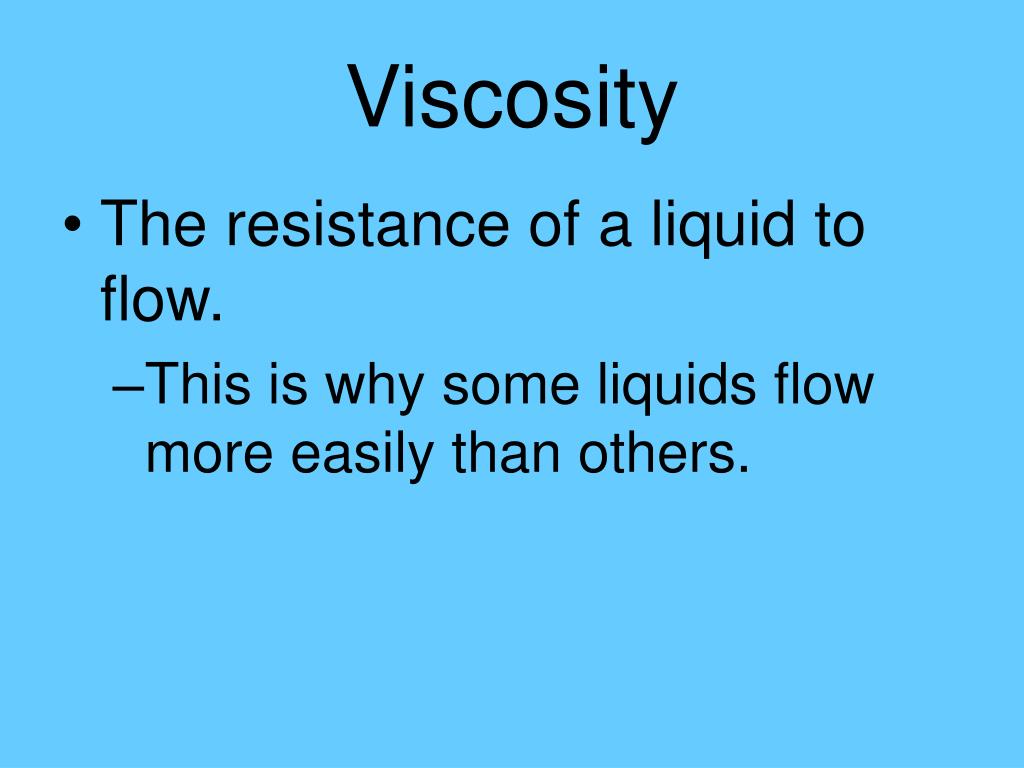

Fluids have zero shear strength, but the rate at which they are sheared is related to the same geometrical factors A A and L L as is shear deformation for solids.įigure 12.12 The graphic shows laminar flow of fluid between two plates of area A A. The motion in Figure 12.12 is like a continuous shearing motion. Care is taken to insure that the flow is laminar that is, the layers do not mix. Each successive layer from the top down exerts a force on the one below it, trying to drag it along, producing a continuous variation in speed from v v to 0 as shown. The layer (or lamina) of fluid in contact with either plate does not move relative to the plate, and so the top layer moves at v v while the bottom layer remains at rest. The bottom plate is held fixed, while the top plate is moved to the right, dragging fluid with it.

Two parallel plates have the specific fluid between them. Which one travels faster? Why?įigure 12.12 shows how viscosity is measured for a fluid. Try dropping simultaneously two sticks into a flowing river, one near the edge of the river and one near the middle. We shall concentrate on laminar flow for the remainder of this section, leaving certain aspects of turbulence for later sections. The drag both between adjacent layers of fluid and between the fluid and its surroundings forms swirls and eddies, if the speed is great enough. First, any obstruction or sharp corner, such as in a faucet, creates turbulence by imparting velocities perpendicular to the flow. Streamlines are smooth and continuous when flow is laminar, but break up and mix when flow is turbulent. The lines that are shown in many illustrations are the paths followed by small volumes of fluids. When there is turbulence, the layers mix, and there are significant velocities in directions other than the overall direction of flow. Layers flow without mixing when flow is laminar.

(credit: Creativity103)įigure 12.11 shows schematically how laminar and turbulent flow differ. If you watch the smoke (being careful not to breathe on it), you will notice that it rises more rapidly when flowing smoothly than after it becomes turbulent, implying that turbulence poses more resistance to flow. The smooth flow is called laminar flow, whereas the swirls and eddies typify turbulent flow. Turbulent flow, or turbulence, is characterized by eddies and swirls that mix layers of fluid together.įigure 12.10 Smoke rises smoothly for a while and then begins to form swirls and eddies. Laminar flow is characterized by the smooth flow of the fluid in layers that do not mix. Before we can define viscosity, then, we need to define laminar flow and turbulent flow. The precise definition of viscosity is based on laminar, or nonturbulent, flow. In this section, we will investigate what factors, including viscosity, affect the rate of fluid flow. In the previous sections we have considered ideal fluids with little or no viscosity. Juice has low viscosity, whereas syrup has high viscosity. We call this property of fluids viscosity. The difference is fluid friction, both within the fluid itself and between the fluid and its surroundings. But when you pour syrup on your pancakes, that liquid flows slowly and sticks to the pitcher.

When you pour yourself a glass of juice, the liquid flows freely and quickly. Explain how pressure drops due to resistance.Calculate flow and resistance with Poiseuille’s law.Define laminar flow and turbulent flow.By the end of this section, you will be able to:


 0 kommentar(er)
0 kommentar(er)
